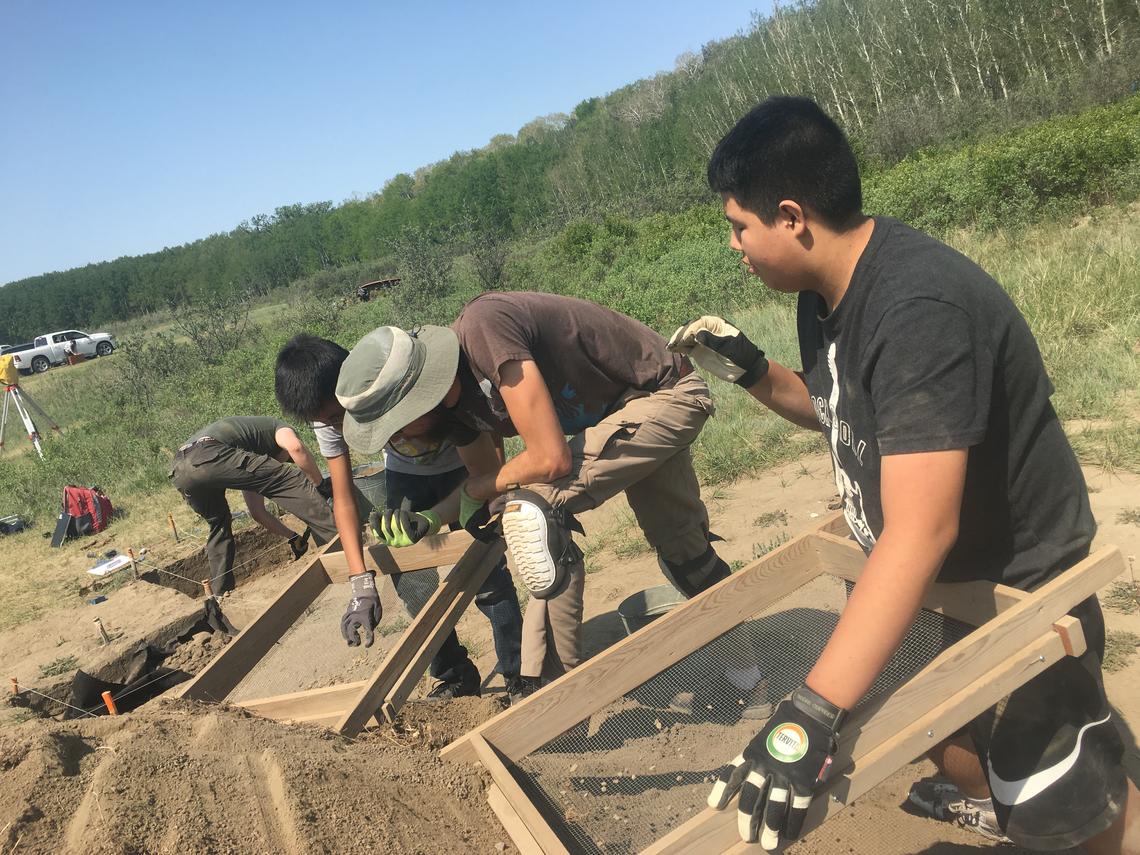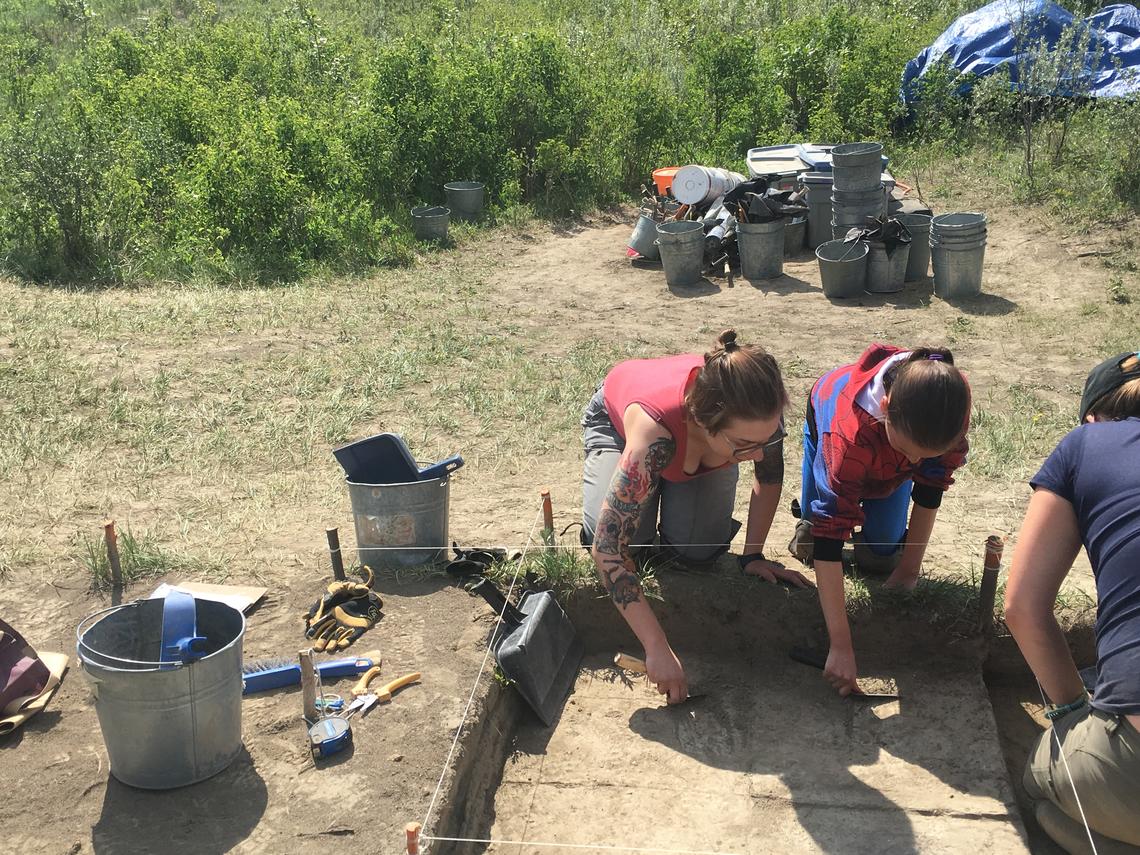June 12, 2018
UCalgary archaeology students spearhead Aboriginal Youth Engagement Program

High school students participate in an archaeology excavation of the Cluny Fortified Village.
Kelsey Pennanen
As she counted down the days leading up to her high school class archaeological dig on Blackfoot territory at the Cluny Fortified Village, nobody was more thrilled for 16-year-old Kerisa McHugh-Kerr than her grandmother.
“My grandma is the one person I always go to for advice on my culture, heritage and history,” says the student from Siksika Nation High School. “She’s so excited for me! I told her about the excavation and she said, ‘I wish I had this opportunity when I was your age. It’s a chance to learn about your people, your ancestors. Take this chance.’ She’s so supportive of it.
“This holds a really good place in my heart right now.”
On June 12, McHugh-Kerr and her classmates will connect with their heritage in a rare and meaningful way at Cluny Fortified Village, located near the Blackfoot Crossing Historical Park and Interpretive Centre.
The high schoolers from Siksika Nation (part of the Blackfoot Confederacy) will work under the tutelage of archaeology field school students and alongside the University of Calgary’s Program for Public Archaeology to take part in an excavation at the Cluny site.
High school students to get their hands dirty
Having completed the program’s classroom component — wherein they learned basic archaeological methods, even reconstructing a full bison skeleton — the Siksika high school students are now ready to get their hands dirty at the Cluny excavation site.
“Participating students get to do an actual dig themselves,” says Kelsey Pennanen, an MA student in the Department of Anthropology and Archaeology, who leads the Aboriginal Youth Engagement Program along with fellow MA students Shalcey Dowkes and Alyssa Haggard.
“We pair them up with experienced archaeology students from the program and they get to excavate — and hopefully uncover something. And they almost always do, because there’s so much to discover at the Cluny site. They’re making notes and documenting their interpretations, using the surveying equipment. It makes for a well-rounded archaeological experience.”

Kelsey Pennanen an archaeology MA students who leads the Aboriginal Youth Engagement Program.
Riley Brandt, University of Calgary
Program intends to inspire Indigenous youth
An initiative in keeping with the University of Calgary’s Indigenous Strategy, this newly launched Aboriginal Youth Engagement Program is of crucial importance for the university’s archaeological field school on the Blackfoot territory as it fosters a mutually beneficial working relationship with Siksika Nation.
“It’s an opportunity for the high school students to connect with a tangible aspect of their heritage in way that gives them ownership and the opportunity to discover and interpret their own story,” says Pennanen. “I think the students feel really empowered by this.
“But it’s valuable for us as archaeology students, too, because we can learn from the perspective of these high school students. They provide insights that may be a lot more holistic than our western scientific perspectives — and that’s important.”
Another goal of the program, says Pennanen, is to make Indigenous students feel welcome, excited and inspired by the possibilities of post-secondary education.
With funding provided by the Calgary Foundation, the Aboriginal Youth Engagement Program has invited six high schools to take part in the Cluny excavation this season.
Cluny Fortified Village has historical and archaeological significance
As the only known prehistoric fortified village on the Canadian Plains, the Cluny Fortified Village is a site of great historic and archaeological significance. First excavated in 1960 by Dr. Richard Forbis, one of the founders of the University of Calgary archaeology program, the site represents one of the few clear archaeological examples of migration and contact between cultures on the Canadian Plains.
Archaeological evidence suggests that approximately 300 years ago a group of people entered Blackfoot territory, prior to the first direct contact between European fur traders and the local Indigenous Peoples. It is believed these new entrants built the Cluny Fortified Village and then, later, abandoned the area. The relationship between the Blackfoot and this foreign group living within their territory is a mystery that archaeologists at the Cluny site have been working to uncover.
In addition, there is also clear evidence of European contact on the Cluny site, demonstrating the impact that was made upon their arrival.
All of this makes the Cluny site an archaeological treasure trove. The University of Calgary has run an archaeology field school at Cluny Fortified Village for the past 12 years.

High school students hard at work at the archaeological excavation.
Kelsey Pennanen
Site is point of pride for Blackfoot students
“I’m amazed by what this site has to offer and our students are so proud that this is on their land, in their home,” says Lisa Calf Robe, a teacher at Siksika Nation High School. “I’m so happy that we’re doing this program with the University of Calgary. It’s a great way for us to showcase what we have to offer as Blackfoot people. And it’s important for our students to know that their culture is being taught out there, that’s it’s valuable.”
McHugh-Kerr agrees. “It’s an amazing feeling that people want to learn about my ancestors and my history. It’s special to me.”
She adds: “My grandma had a garage sale the other day and she was trying to sell these old gardening gloves. I said, ‘No grandma, I’m taking these for the dig!’
“I’m so excited.”
